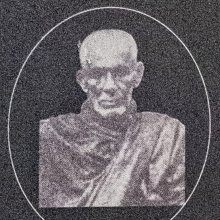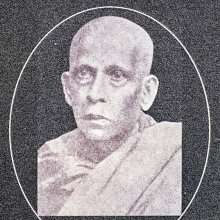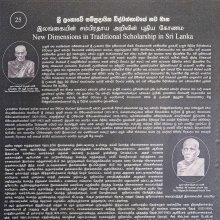Tera, Ṭēra, Ṭera, Ṭērā, Tēṟa: 16 definitions
Introduction:
Tera means something in Hinduism, Sanskrit, Marathi, Jainism, Prakrit, Hindi, biology, Tamil. If you want to know the exact meaning, history, etymology or English translation of this term then check out the descriptions on this page. Add your comment or reference to a book if you want to contribute to this summary article.
Images (photo gallery)
(+6 more images available)
In Hinduism
Ayurveda (science of life)
Nighantu (Synonyms and Characteristics of Drugs and technical terms)
Source: WorldCat: Rāj nighaṇṭuTera (तेर) is another name for Tairiṇī, an unidentified medicinal plant, according to verse 4.127 of the 13th-century Raj Nighantu or Rājanighaṇṭu. The fourth chapter (śatāhvādi-varga) of this book enumerates eighty varieties of small plants (pṛthu-kṣupa). Note Tairiṇī is an unidentified plant introduced by the Rājanighaṇṭu. Together with the names Tera and Tairiṇī, there are a total of four Sanskrit synonyms identified for this plant.

Āyurveda (आयुर्वेद, ayurveda) is a branch of Indian science dealing with medicine, herbalism, taxology, anatomy, surgery, alchemy and related topics. Traditional practice of Āyurveda in ancient India dates back to at least the first millenium BC. Literature is commonly written in Sanskrit using various poetic metres.
Biology (plants and animals)
Source: Wisdom Library: Local Names of Plants and DrugsTera in the Bengali language is the name of a plant identified with Etlingera linguiformis (Roxb.) R.M.Sm. from the Zingiberaceae (Ginger) family having the following synonyms: Amomum linguiforme, Cardamomum linguiforme, Elettaria linguiformis. For the possible medicinal usage of tera, you can check this page for potential sources and references, although be aware that any some or none of the side-effects may not be mentioned here, wether they be harmful or beneficial to health.
Tera in the Manipuri language is the name of a plant identified with Bombax ceiba L. from the Malvaceae (Mallow) family having the following synonyms: Salmalia malabarica.
Source: Google Books: CRC World Dictionary (Regional names)1) Tera in Bangladesh is the name of a plant defined with Amomum maximum in various botanical sources. This page contains potential references in Ayurveda, modern medicine, and other folk traditions or local practices It has the synonym Cardamomum maximum (Roxb.) Kuntze (among others).
2) Tera in Gabon is also identified with Desbordesia glaucescens It has the synonym Irvingia oblonga A. Chev. (etc.).
3) Tera in India is also identified with Bombax ceiba It has the synonym Salmalia malabarica (DC.) Schott & Endl. (etc.).
4) Tera is also identified with Pachira glabra It has the synonym Sophia carolina L. (etc.).
Example references for further research on medicinal uses or toxicity (see latin names for full list):
· FBI (1874)
· Folia Malaysiana (2002)
· Flora Indica, or ‘Descriptions of Indian Plants’ (1768)
· Revisio Generum Plantarum (1891)
· Prodromus Systematis Naturalis Regni Vegetabilis (DC.) (1824)
· Bulletin du Jardin Botanique de l’État (1963)
If you are looking for specific details regarding Tera, for example diet and recipes, health benefits, side effects, pregnancy safety, extract dosage, chemical composition, have a look at these references.

This sections includes definitions from the five kingdoms of living things: Animals, Plants, Fungi, Protists and Monera. It will include both the official binomial nomenclature (scientific names usually in Latin) as well as regional spellings and variants.
Languages of India and abroad
Marathi-English dictionary
Source: DDSA: The Molesworth Marathi and English Dictionaryṭēra (टेर).—f Glutted or filled state, satedness or satiety. 2 (Or ṭara) Ridiculing: also ridiculed state. v kara, uḍava.
--- OR ---
tēra (तेर).—f The third ploughing (of a field).
--- OR ---
tērā (तेरा).—a Thirteen.
Source: DDSA: The Aryabhusan school dictionary, Marathi-Englishṭēra (टेर).—f Glutted or filled state. Ridiculing: also ridiculed state.
--- OR ---
tērā (तेरा).—a Thirteen. tērābārā a (Thirteen and twelve.) Sixes and sevens. Used pl Ex. tyācē mājhē tērābārā cālalē āhēta.
Marathi is an Indo-European language having over 70 million native speakers people in (predominantly) Maharashtra India. Marathi, like many other Indo-Aryan languages, evolved from early forms of Prakrit, which itself is a subset of Sanskrit, one of the most ancient languages of the world.
Sanskrit dictionary
Source: DDSA: The practical Sanskrit-English dictionaryṬera (टेर).—a. Squint-eyed.
See also (synonyms): ṭeraka.
Source: Cologne Digital Sanskrit Dictionaries: Shabda-Sagara Sanskrit-English DictionaryṬera (टेर).—mfn.
(-raḥ-rā-raṃ) Squint-eyed.
Source: Cologne Digital Sanskrit Dictionaries: Monier-Williams Sanskrit-English Dictionary1) Ṭera (टेर):—mfn. squinting, [Horace H. Wilson]
2) Tera (तेर):—m. balsamine, [cf. Lexicographers, esp. such as amarasiṃha, halāyudha, hemacandra, etc.]
Source: Cologne Digital Sanskrit Dictionaries: Yates Sanskrit-English DictionaryṬera (टेर):—[(raḥ-rā-raṃ) a.] Squint-eyed.
[Sanskrit to German]
Sanskrit, also spelled संस्कृतम् (saṃskṛtam), is an ancient language of India commonly seen as the grandmother of the Indo-European language family (even English!). Closely allied with Prakrit and Pali, Sanskrit is more exhaustive in both grammar and terms and has the most extensive collection of literature in the world, greatly surpassing its sister-languages Greek and Latin.
Hindi dictionary
Source: DDSA: A practical Hindi-English dictionary1) Ṭera (टेर) [Also spelled ter]:—(nf) a call; loud appeal/summon.
2) Terā (तेरा) [Also spelled tara]:—(pro) possessive form of [tū]—thy, thine, your(s); -[sā/terī-sī] favourable to you, serving your interest.
...
Prakrit-English dictionary
Source: DDSA: Paia-sadda-mahannavo; a comprehensive Prakrit Hindi dictionary1) Tera (तेर) in the Prakrit language is related to the Sanskrit word: Trayodaśa.
2) Tera (तेर) also relates to the Sanskrit word: Trayodaśan.
2) Tera has the following synonyms: Terasa.
Prakrit is an ancient language closely associated with both Pali and Sanskrit. Jain literature is often composed in this language or sub-dialects, such as the Agamas and their commentaries which are written in Ardhamagadhi and Maharashtri Prakrit. The earliest extant texts can be dated to as early as the 4th century BCE although core portions might be older.
Kannada-English dictionary
Source: Alar: Kannada-English corpusTera (ತೆರ):—
1) [noun] 'a way of doing, being, being done or happening; mode of action, occurrence, etc.: manner.'2) [noun] the quality that attracts the mind; beauty; attractiveness.
3) [noun] a matter or subject.
4) [noun] something that is helpful or useful to a desired end; a means.
--- OR ---
Tera (ತೆರ):—
1) [noun] something given as a gift, esp. to a temple, revered person, etc.
2) [noun] a compulsory payment, usu. a percentage, levied on income, property value, sales price or goods transported, etc. for the support of a government; a tax.
3) [noun] a gift of money, property, etc. that is presented to a woman at her marriage by her husband’s family.
4) [noun] a sum of money paid or required to be paid as punishment or penalty for an offence; fine.
--- OR ---
Teṟa (ತೆಱ):—
1) [noun] a way of doing, being, being done or happening; mode of action, occurrence, etc.; manner.
2) [noun] the quality that attracts the mind; beauty; attractiveness.
3) [noun] a matter or subject.
4) [noun] something that is helpful or useful to a desired end; a means.
--- OR ---
Teṟa (ತೆಱ):—
1) [noun] something given as a gift, esp. to a temple, revered person, etc.
2) [noun] a compulsory payment, usu. a percentage, levied on income, property value, sales price or goods transported, etc. for the support of a government; a tax.
3) [noun] a gift of money, property, etc. that is presented to a woman at her marriage by her husband’s family.
4) [noun] a sum of money paid or required to be paid as punishment or penalty for an offence; fine.
--- OR ---
Tēra (ತೇರ):—
1) [noun] a Jaina or Buddhist sage.
2) [noun] an aged, elderly man.
Kannada is a Dravidian language (as opposed to the Indo-European language family) mainly spoken in the southwestern region of India.
Tamil dictionary
Source: DDSA: University of Madras: Tamil LexiconṬērā (டேரா) noun < Hindustain ḍērā.
1. Tent; கூடாரம். [kudaram.]
2. Camp; முகாம். [mugam.]
--- OR ---
Tēṟa (தேற) adverb < தேறு-. [theru-.] Thoroughly; கடைபோக. தேற விசாரிக்கவேணும். [kadaipoga. thera visarikkavenum.]
Tamil is an ancient language of India from the Dravidian family spoken by roughly 250 million people mainly in southern India and Sri Lanka.
Nepali dictionary
Source: unoes: Nepali-English DictionaryṬera (टेर):—n. obedience; attention; response;
Nepali is the primary language of the Nepalese people counting almost 20 million native speakers. The country of Nepal is situated in the Himalaya mountain range to the north of India.
See also (Relevant definitions)
Starts with (+21): Tera-paibi, Terabara, Terada, Teragol, Terah, Teraha, Terahapamtha, Terahim, Terahu, Terahugan, Terahugodu, Terahugudu, Terahukodu, Terahumarahu, Teraisu, Teraje, Teraka, Terakai, Terakara, Teraki.
Query error!
Full-text (+1116): Thera, Theravada, Dera, Dhera, Teram, Teraka, Theragatha, Dheras, Dera-basnu, Teravada, Terasa, Tehara, Terakai, Ter, Khaali-man-satanako-deraa, Khali-mana-saitanako-dera, Teras sudu, Terah, Sthavira, Sathera.
Relevant text
Search found 112 books and stories containing Tera, Daeraa, Dera, Deraa, Dhera, Ṭēra, Ṭera, Tēra, Tērā, Terā, Teṟa, Ṭērā, Tēṟa, Thaera, Thera; (plurals include: Teras, Daeraas, Deras, Deraas, Dheras, Ṭēras, Ṭeras, Tēras, Tērās, Terās, Teṟas, Ṭērās, Tēṟas, Thaeras, Theras). You can also click to the full overview containing English textual excerpts. Below are direct links for the most relevant articles:
Mahavamsa (by Wilhelm Geiger)
Philosophy of language in the Five Nikayas (by K.T.S. Sarao)
2.1. The First Buddhist Council < [Chapter 1 - Introduction]
2.3. The Third Buddhist Council < [Chapter 1 - Introduction]
4. Conclusion < [Chapter 6 - Summary and Conclusions]
A Discourse on Paticcasamuppada (by Venerable Mahasi Sayadaw)
Chapter 8 - The Story Of Cakkhupala Thera < [Part 3]
Chapter 10 - Story Of Yamaka < [Part 9]
Chapter 6 - Knowledge For Vipassana Practice < [Part 9]
Vinaya (2): The Mahavagga (by T. W. Rhys Davids)
Mahavagga, Khandaka 1, Chapter 74 < [Khandaka 1 - The Admission to the Order of Bhikkhus]
Mahavagga, Khandaka 8, Chapter 24 < [Khandaka 8 - The Dress of the Bhikkhus]
Mahavagga, Khandaka 2, Chapter 10 < [Khandaka 2 - The Uposatha Ceremony, and the Patimokkha]
Guide to Tipitaka (by U Ko Lay)
Part 9 - The Theri Gatha Pali < [Chapter VIII - Khuddaka Nikaya]
Part 13 - Apadana Pali < [Chapter VIII - Khuddaka Nikaya]
Apadana commentary (Atthakatha) (by U Lu Pe Win)
Commentary on the stanza on bahussuta (much learned) < [Commentary on biography of Silent Buddhas (Paccekabuddha)]
Buddha finds disciples and starts his order < [Part 3 - Discourse on proximate preface (santike-nidāna)]
Commentary on Biography of the thera Kuṇḍadhāna < [Chapter 4 - Kuṇḍadhānavagga (section on Kuṇḍadhāna)]





